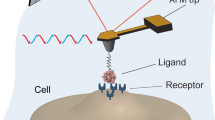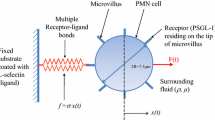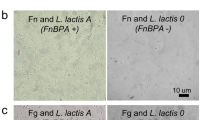Abstract
The kinetic and thermodynamic properties of a peptide–receptor interaction was investigated by measuring the adhesion force in the reaction via atomic force microscopy (AFM). Trp-Lys-Tyr-Met-Val-D-Met (WKYMVm), considered as a model system in the present study, is a potent neutrophil chemo-attractant. Since being identified as an agonist for formyl peptide receptor (FPR), WKYMVm’s high affinity to FPR has been verified through investigation of its kinetic and physiological behaviors via conventional methods. However, there have been no reports on the adhesion force of WKYMVm-FPR. In this research, we measured the adhesion force of WKYMVm-FPR using AFM. Kinetic parameters obtained from the relationship between the adhesion force and loading rate were used to characterize the thermodynamic properties of WKYMVm-hFPR binding.





Similar content being viewed by others
References
Bae YS, Lee HY, Jo EJ et al (2004) Identification of peptides that antagonize formyl peptide receptor-like 1-mediated signaling. J Immunol 173:607–614
Baek SH, Seo JK, Chae CB et al (1996) Identification of the peptides that stimulate the phosphoinositide hydrolysis in lymphocyte cell lines from peptide libraries. J Biol Chem 271:8170–8175
Baggiolini M, Walz A, Kunkel SL (1989) Neutrophil-activating peptide-1/interleukin 8, a novel cytokine that activates neutrophils. J Clin Invest 84:1045–1049
Boulay F, Tardif M, Brouchon L et al (1990) The human N-formylpeptide receptor. Characterization of two cDNA isolates and evidence for a new subfamily of G-protein-coupled receptors. Biochemistry 29:11123–11133
Evans E (2001) Probing the relation between force–lifetime–and chemistry in single molecular bonds. Annu Rev Biomol Struct 30:105–128
Hall AL, Wilson BS, Pfeiffer JR et al (1997) Relationship of ligand–receptor dynamics to actin polymerization in RBL-2H3 cells transfected with the human formyl peptide receptor. J Leukoc Biol 62:35–546
He R, Tan L, Browning DD et al (2000) The synthetic peptide Trp-Lys-Tyr-Met-Val-D-Met is a potent chemotactic agonist for mouse formyl peptide receptor. J Immunol 165:4598–4605
Hinterdorfer P, Baumgartner W, Gruber HJ et al (1996) Detection and localization of individual antibody-antigen recognition events by atomic force microscopy. Proc Natl Acad Sci USA 93:3477–3481
Karlsson J, Fu H, Boulay F et al (2006) The peptide Trp-Lys-Tyr-Met-Val-D-Met activates neutrophils through the formyl peptide receptor only when signaling through the formylpeptide receptor like 1 is blocked A receptor switch with implications for signal transduction studies with inhibitors and receptor antagonists. Biochem Pharmacol 71:1488–1496
Key TA, Foutz TD, Gurevich VV et al (2003) N-formyl peptide receptor phosphorylation domains differentially regulate arrestin and agonist affinity. J Biol Chem 278(6):4041–4047
Kim H, Noh EK, Lee EJ et al (2007) Enhanced bactericidal function by WKYMVm in patients with acute leukemia. Leuk Res 32:717–725
Le Y, Gong W, Li B et al (1999) Utilization of two-seven-transmembrane, G protein-coupled receptors, formyl peptide receptor-like 1 and formyl peptide receptor, by the synthetic hexapeptide WKYMVm for human phagocyte activation. J Immunol 163:6777–6784
Lee IS, Marchant RE (2001) Force measurements on the molecular interactions between ligand (RGD) and human platelet αIIbβ3 receptor system. Surf Sci 491:433–443
Merkel R, Nassoy P, Leung A et al (1999) Energy landscapes of receptor–ligand bonds explored with dynamic force spectroscopy. Nature 397(7):50–53
Moy VT, Florin EL, Gaub HE (1994) Intermolecular forces and energies between ligands and receptors. Science 266(14):257–259
O’Flaherty TJT, Surles JR, Redman J et al (1986) Binding and metabolism of platelet-activating factor by human neutrophils. J Clin Invest 78:381–388
Psychoyos S, Smith CW (1989) Enhancement of N-formyl-methionyl-leucyl-phenylalanine (fMLP) binding to isolated human neutrophils. Agents Actions 26:372–377
Ros R, Schwesinger F, Anselmetti D et al (1998) Antigen binding forces of individually addressed single-chain Fv antibody molecules. Proc Natl Acad Sci USA 95:7402–7405
Seo JK, Choi SY, Kim Y et al (1997) A peptide with unique receptor specificity: stimulation of phosphoinositide hydrolysis and induction of superoxide generation in human neutrophils. J Immunol 158(4):1895–1901
Shin HS, Snyderman R, Friedman E et al (1968) Chemotactic and anaphylatoxic fragment cleaved from the fifth component of complement. Science 162:361–363
Tees DF, Waugh RE, Hammer DA (2001) A microcantilever device to assess the effect of force on the lifetime of selectin-carbohydrate bonds. Biophys J 80:668–682
Yuan C, Chen A, Kolb P et al (2000) Energy landscape of streptavidin–biotin complexes measured by atomic force microscopy. Biochemistry 39:10219–10223
Zeder-Lutz G, Zuber E, Witz J et al (1997) Thermodynamic analysis of antigen–antibody binding using biosensor measurements at different temperatures. Anal Biochem 246:123–132
Zhang X, Moy VT (2003) Mechanisms for cooperative adhesion of ligandreceptor bonds. Biophys Chem 104(1):271–278
Acknowledgement
H.S. Shin acknowledges support from Inha University’s internal research fund.
Author information
Authors and Affiliations
Corresponding authors
Rights and permissions
About this article
Cite this article
Cho, J.H., Cho, K. & Shin, H.S. Kinetic and thermodynamic analyses of adhesion of a peptide, Trp-Lys-Tyr-Met-Val-D-Met (WKYMVm), and human formyl peptide receptor (hFPR). Biotechnol Lett 32, 773–779 (2010). https://doi.org/10.1007/s10529-010-0226-8
Received:
Revised:
Accepted:
Published:
Issue Date:
DOI: https://doi.org/10.1007/s10529-010-0226-8




